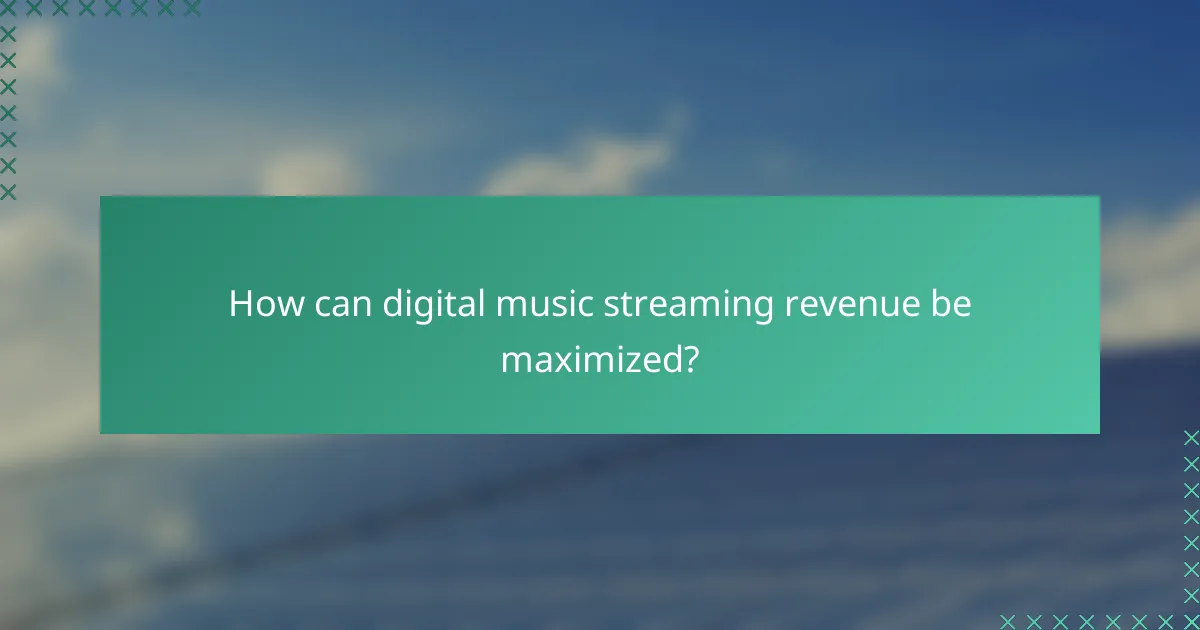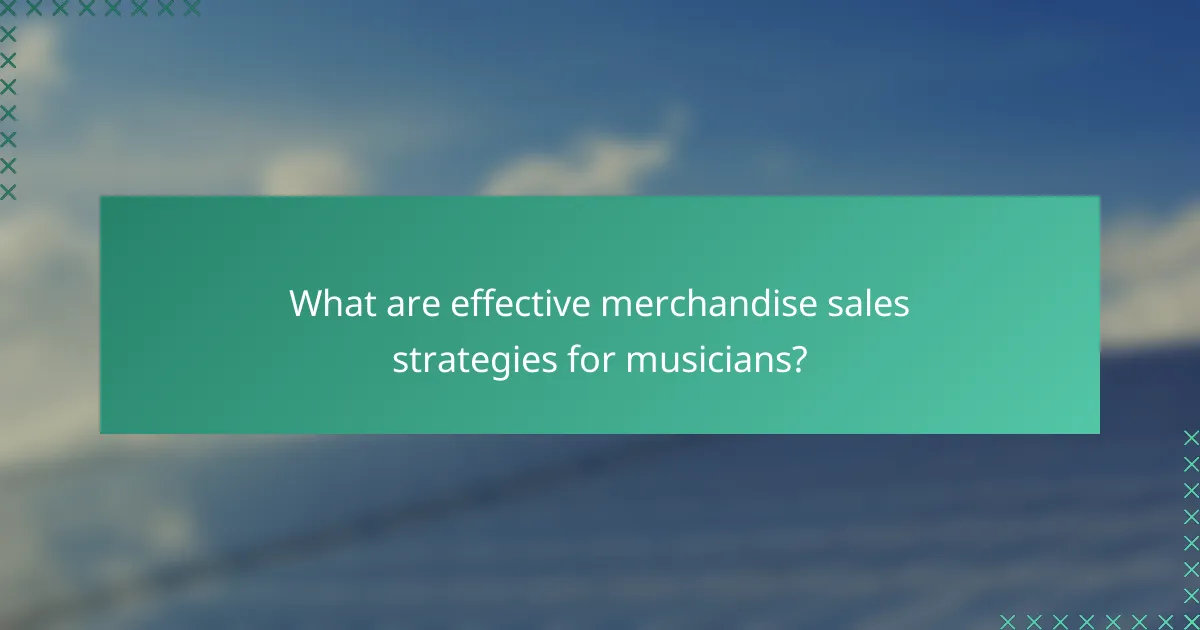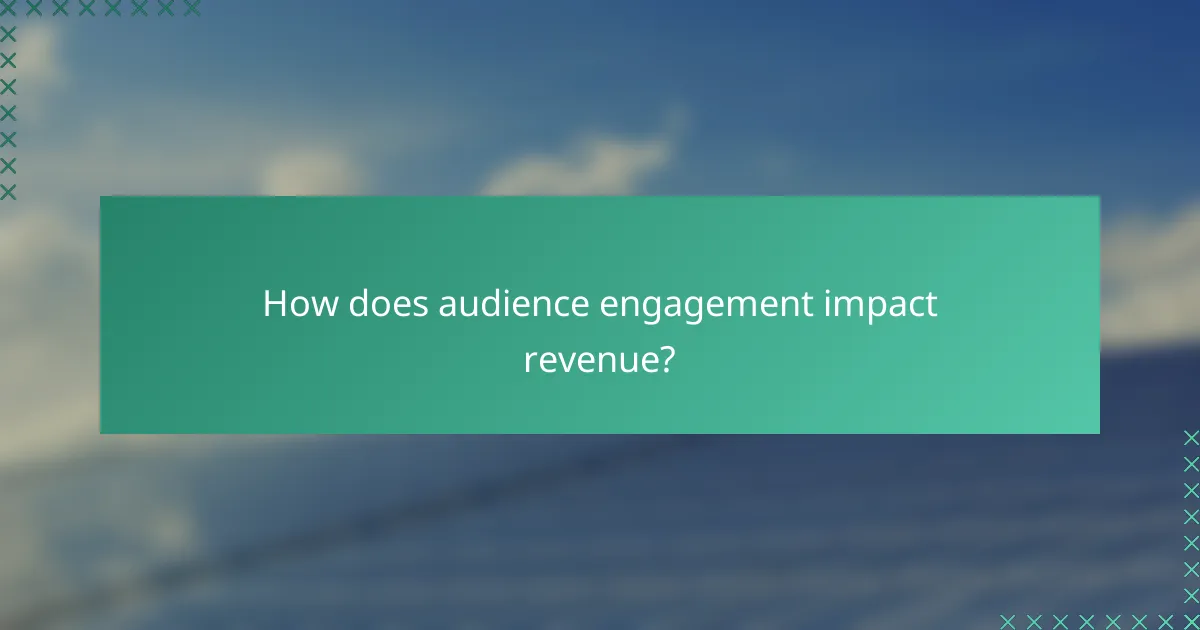The digital music landscape has transformed how artists generate revenue, with streaming and merchandise sales playing pivotal roles. By employing targeted promotional strategies and leveraging audience insights, musicians can maximize their earnings and enhance their visibility in a competitive market. Effective approaches to merchandise and streaming not only boost income but also strengthen the connection between artists and their fans.

How can digital music streaming revenue be maximized?
Maximizing digital music streaming revenue involves leveraging various promotional strategies, subscription models, and audience insights. By effectively utilizing available tools and data, artists and labels can enhance their revenue streams significantly.
Utilizing Spotify’s promotional tools
Spotify offers several promotional tools that can help artists increase their visibility and streaming numbers. Features like Spotify for Artists allow musicians to manage their profiles, submit songs for playlists, and analyze listener data.
Utilizing Spotify’s playlist submission feature can lead to increased exposure, as getting featured on popular playlists can boost streams significantly. Artists should regularly engage with their audience through Spotify’s Canvas and Story features to maintain listener interest.
Implementing tiered subscription models
Tiered subscription models can enhance revenue by offering different levels of access to content. For example, artists can provide exclusive content or early access to new releases for premium subscribers, creating an incentive for fans to upgrade.
Consider offering a basic free tier with ads, a mid-level ad-free experience, and a premium tier that includes exclusive merchandise or concert tickets. This approach can cater to various audience segments while maximizing overall revenue potential.
Leveraging data analytics for audience targeting
Data analytics play a crucial role in understanding audience behavior and preferences. By analyzing streaming data, artists can identify which songs resonate most with listeners and tailor their promotional strategies accordingly.
Utilizing tools like Spotify Wrapped or third-party analytics platforms can provide insights into listener demographics, allowing for targeted marketing campaigns. Artists should focus on creating personalized content and promotions based on these insights to enhance engagement and drive revenue.

What are effective merchandise sales strategies for musicians?
Effective merchandise sales strategies for musicians focus on creating unique products that resonate with fans, leveraging online platforms for distribution, and promoting items through social media channels. By implementing these strategies, artists can enhance their brand and generate additional revenue streams.
Creating exclusive artist merchandise
Exclusive merchandise can significantly boost sales by offering fans unique items that reflect their connection to the artist. Consider limited edition products, such as signed albums, custom apparel, or unique artwork, which can create a sense of urgency and exclusivity.
When designing merchandise, prioritize quality and originality. Collaborating with local artists or designers can help create distinctive items that stand out. Additionally, consider bundling merchandise with concert tickets to increase perceived value and drive sales.
Partnering with platforms like Bandcamp
Partnering with platforms like Bandcamp allows musicians to sell merchandise directly to fans while retaining a larger share of profits. Bandcamp offers tools for artists to create their own storefronts, making it easy to showcase and sell both music and merchandise.
Utilizing such platforms can also enhance visibility, as they often have built-in audiences of music enthusiasts. Artists should regularly update their offerings and promote new releases or exclusive items to keep fans engaged and encourage repeat purchases.
Utilizing social media for merchandise promotion
Social media is a powerful tool for promoting merchandise, enabling artists to reach a broad audience quickly. Regularly posting engaging content, such as behind-the-scenes looks at merchandise production or fan testimonials, can drive interest and sales.
Consider running targeted ad campaigns on platforms like Instagram and Facebook to reach specific demographics. Additionally, utilizing features like Instagram Shopping can streamline the purchasing process, allowing fans to buy directly from posts. Engaging with fans through live streams or Q&A sessions can also create excitement around new merchandise launches.

What promotional strategies enhance digital music visibility?
Effective promotional strategies significantly boost digital music visibility by leveraging social media platforms, targeted advertising, and collaborations. These methods help artists reach broader audiences and engage fans more effectively.
Collaborating with influencers on TikTok
Partnering with influencers on TikTok can rapidly increase an artist’s visibility. Influencers often have dedicated followings that trust their recommendations, making them ideal for promoting new music. A well-crafted challenge or dance can go viral, leading to increased streams and downloads.
When collaborating, choose influencers whose style aligns with your music genre. This ensures authenticity and resonates with their audience. Consider offering exclusive content or behind-the-scenes access to enhance engagement.
Running targeted ad campaigns on Facebook
Targeted ad campaigns on Facebook allow artists to reach specific demographics based on interests, age, and location. This precision helps maximize the effectiveness of promotional budgets, ensuring that ads are shown to potential fans who are likely to engage with the music.
To create successful campaigns, use eye-catching visuals and compelling calls to action. Monitor ad performance regularly and adjust targeting parameters as needed to optimize results. A/B testing different ad formats can also help identify what resonates best with your audience.
Engaging in cross-promotion with other artists
Cross-promotion with other artists can expand reach and introduce music to new audiences. By collaborating on tracks, sharing each other’s content, or hosting joint events, artists can leverage each other’s fan bases for mutual benefit.
Choose artists with complementary styles or similar audience demographics for effective cross-promotion. This strategy not only enhances visibility but also fosters a sense of community within the music scene. Regularly engage with each other’s followers to maintain momentum and interest.

What criteria should be considered for selecting a streaming platform?
When selecting a streaming platform, consider factors such as revenue share models, user demographics, and engagement levels. These criteria will help ensure that the platform aligns with your financial goals and audience preferences.
Revenue share models
Revenue share models determine how much of the income generated from streams goes to the artist versus the platform. Common models include fixed percentages, tiered systems based on performance, or flat fees per stream. For instance, some platforms may offer artists around 60-70% of the revenue, while others might retain a larger share.
Evaluate the revenue share structure carefully, as it can significantly impact your earnings. Look for platforms that provide transparency in their payment processes and consider negotiating terms if possible. Understanding the model can help you choose a platform that maximizes your revenue potential.
User demographics and engagement
Understanding user demographics and engagement is crucial for selecting a streaming platform that reaches your target audience. Analyze the age, location, and listening habits of users on different platforms to ensure alignment with your music style. For example, younger audiences may prefer platforms like TikTok or Spotify, while older demographics might lean towards Apple Music.
Engagement metrics, such as average listening time and interaction rates, also play a vital role. High engagement indicates a loyal audience, which can lead to better merchandise sales and promotional opportunities. Consider platforms that offer analytics tools to track these metrics and adjust your strategies accordingly.

How does audience engagement impact revenue?
Audience engagement significantly influences revenue by fostering stronger connections between artists and their fans. Engaged audiences are more likely to support artists through streaming, merchandise purchases, and participation in promotional activities.
Building a loyal fanbase through newsletters
Newsletters are an effective tool for building a loyal fanbase, as they allow artists to communicate directly with their audience. By sharing exclusive content, upcoming releases, and personal stories, artists can create a sense of intimacy that encourages fans to remain engaged.
To maximize the impact of newsletters, artists should focus on consistency and personalization. Sending regular updates, ideally weekly or bi-weekly, keeps fans informed and involved. Including personalized messages or special offers can further enhance the connection.
Hosting live virtual events
Live virtual events provide an opportunity for artists to engage with their audience in real-time, enhancing the fan experience. These events can include live concerts, Q&A sessions, or behind-the-scenes looks, allowing fans to feel more connected to the artist.
When planning virtual events, consider using platforms that facilitate interaction, such as Zoom or Twitch. Promoting these events through social media and newsletters can help increase attendance. Offering exclusive merchandise or access to future events as incentives can also boost participation and revenue.

What emerging trends are shaping the digital music industry?
Emerging trends in the digital music industry include the rise of streaming revenue, the integration of merchandise sales, and innovative promotional strategies. These trends are reshaping how artists connect with fans and monetize their work in a rapidly evolving landscape.
Streaming revenue growth
Streaming revenue has become the dominant source of income for many artists, surpassing traditional sales. Platforms like Spotify, Apple Music, and YouTube Music offer subscription models and ad-supported tiers, allowing users to access vast libraries of music for a monthly fee or for free with ads.
Artists typically earn a fraction of a cent per stream, which can accumulate significantly with millions of listeners. To maximize earnings, musicians should focus on building a loyal fanbase and engaging with listeners through social media and live performances.
Merchandise sales integration
Merchandise sales are increasingly integrated into digital music strategies, providing artists with additional revenue streams. This includes selling branded apparel, physical albums, and exclusive items directly through streaming platforms or personal websites.
By promoting merchandise during live streams or through social media, artists can enhance their brand and foster a deeper connection with fans. Offering limited-edition items can create urgency and drive sales, particularly during album releases or tours.
Innovative promotional strategies
Innovative promotional strategies are crucial for artists to stand out in a crowded market. Collaborations with influencers, engaging content on platforms like TikTok, and interactive fan experiences can significantly boost visibility and engagement.
Utilizing data analytics to understand audience preferences can help tailor promotional efforts effectively. Artists should consider leveraging social media ads, email marketing, and partnerships with brands to reach wider audiences and enhance their promotional impact.
